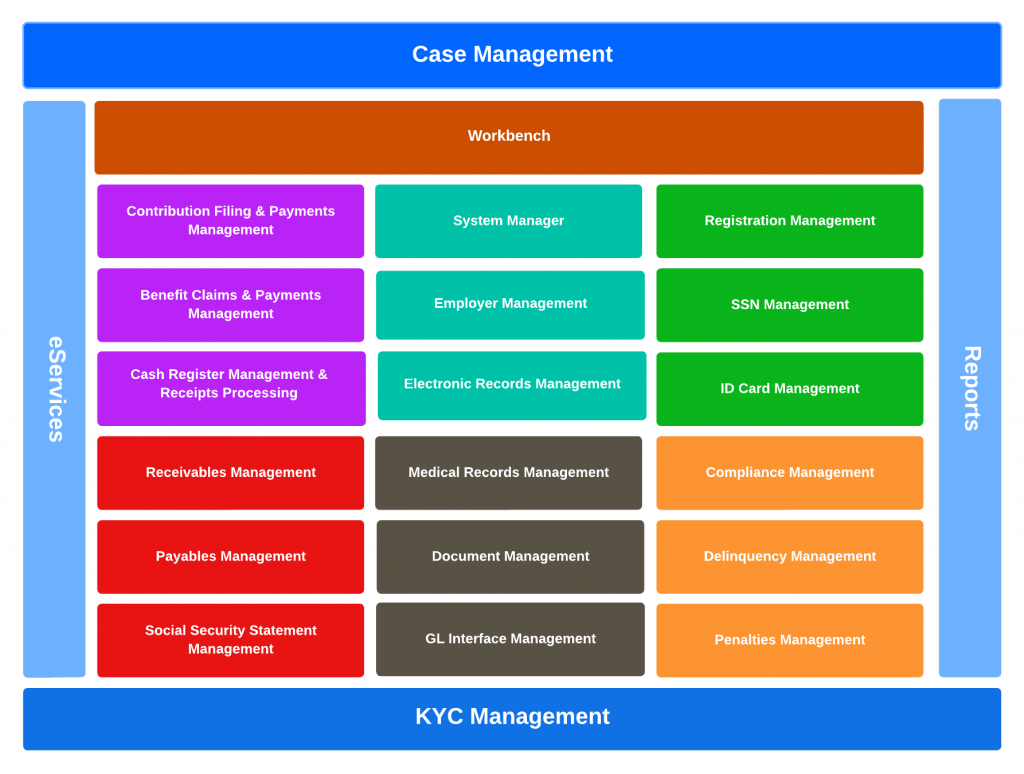In today’s rapidly evolving digital landscape, organizations dealing with large volumes of sensitive data, such as social security administrations, need to have the best tools for managing complex business processes. Many organizations have had to make do, until now, with multiple different solutions to handle different aspects of their business processes. Quite a few social security administrations to this day operate one software to manage registrations, another one to manage benefit claims, another ERP system to manage the payment of such benefit claims and Solutions like Interact SSAS, an integrated system designed to address all social security administration needs in one singly system, highlight the benefits of having a unified approach to such critical functions. The key advantage is clear: having all modules—ranging from registration to compliance management—within a single system promotes efficiency, data integrity, and customer satisfaction while ensuring regulatory compliance.
- Data Integrity
In an integrated system like Interact SSAS, all modules share a common platform and database. This ensures that data entered in one part of the system is available throughout. For example, when an employer or individual is registered, the details automatically populate into other modules such as contributions filing, benefit claims and compliance management. This eliminates the need for duplicate data entry and significantly reduces the risk of errors.
In a non-integrated system, data must be transferred between multiple systems or applications, often leading to inconsistencies or data mismatches. A single system safeguards the integrity of data by maintaining a central repository, ensuring that all departments or modules operate on the same version of information. This becomes critical in processes such as benefits calculation, where even minor errors in data can have significant consequences.
- Improved Efficiency and Workflow
An integrated system automates various processes across modules, reducing manual work. For instance, in Interact SSAS, registration details feed directly into modules such as compliance management and contributions filing. The system automatically applies relevant rules, rates, and penalties, allowing staff to focus on exceptions and approvals instead of data processing. This streamlines operations, reduces the workload for administrators, and improves the overall speed of transactions.
Having separate systems for each module would involve manually transferring data and processing tasks, creating inefficiencies and potential delays. This inefficiency often leads to slower response times, negatively impacting the customer experience.
- Increased Customer Satisfaction
One of the major benefits of an integrated system is its ability to enhance user experiences through self-service capabilities. Interact SSAS, for example, offers e-Services portals for employers, employees, and beneficiaries. Customers can manage their accounts, submit claims, make contribution payments, and view their transaction history—all without needing to visit a social security administration office. This 24/7 access improves customer satisfaction by offering convenience and immediate access to personal data.
In contrast, a fragmented system requires customers to interact with different systems for different needs, increasing the complexity of transactions. A streamlined approach ensures transparency, convenience, and faster processing, leading to higher satisfaction levels.
- Ensuring Compliance
Social security administrations operate under strict legal and regulatory frameworks. Ensuring compliance with these regulations is critical to avoid penalties and maintain operational integrity. Interact SSAS integrates modules for compliance management, delinquency management, case management, KYC management and penalties management, ensuring that all entities (employers, individuals, healthcare providers) remain compliant with all applicable laws.
By increasing the options for automated compliance checks and audit trails across the system, an integrated platform significantly reduces the chances of non-compliance. Auditors and inspectors also have a more complete view of the data for individuals and employers and can more easily spot anomalies with the help of an integrated system. Alerts and powerful reports can provide information to the auditors for faster and more targeted follow-up. Moreover, integrated systems are better equipped to handle frequent regulatory updates, as changes made in one area (e.g., contribution rates) automatically flow through to relevant modules.
- Reduced Risk of Fraud
With a single integrated platform, there is improved monitoring and transparency. All data is tracked and recorded across different functions, with audit trails providing visibility into who accessed what and when. For example, when penalties are imposed for delinquency, the system ensures that the employer or individual’s status is updated across all modules in real-time, reducing the chances of oversight or manipulation.
Separate systems can make it easier for fraudulent activities to slip through the cracks since discrepancies between systems can go unnoticed. By centralizing data, Interact SSAS mitigates these risks and ensures stricter internal controls.
- Cost Savings
From an organizational standpoint, a single system reduces overall costs. Maintaining, updating, and troubleshooting multiple systems for different functional areas can be resource-intensive. Licensing fees, technical support, and personnel training costs are also higher when managing separate applications. With a unified solution, these costs are minimized, and resources can be allocated more efficiently.
Additionally, integrated systems are scalable and can be easily adapted as the organization grows or as new regulations come into play, avoiding the need to invest in new systems for each emerging requirement.
Conclusion
In conclusion, having a single integrated system, like Interact SSAS, provides a cohesive and efficient way to manage all social security administration functions. From ensuring data integrity and streamlining workflows to enhancing customer satisfaction and maintaining regulatory compliance, the benefits of integration are clear. Organizations that adopt such unified solutions will be better equipped to manage the increasing complexity of social security processes, minimize errors, and enhance the overall experience for both administrators and beneficiaries.

